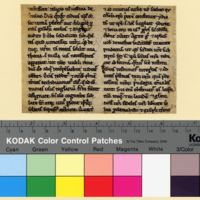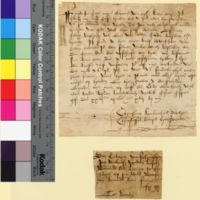Fragmenta Manuscripta
Epistulae
It may seem strange that the personal letters or epistulae of some people would be the subject of later editions, recopied by monastic and professional scribes centuries after the original author laid ink to parchment, but they play a key role in our understanding of the historic events, ways of thinking, and even provide a basis for understating the formation of law codes. For instance, the personal letters, or Decretals, of some popes were gathered together to form the basis of canon law.
A fragment of the epistulae of Arnulf of Lisieux (1104/1109-1184) resides in the Fragmenta Manuscripta collection. Arnulf was a Bishop of Lisieux, went on crusade in 1147, and was an advocate for several English kings and popes. He supported King Stephen of England during the period known as The Anarchy when the throne of England was fought over between two cousins, Stephen and the Empress Matilda. Arnulf also intervened during the controversy with King Henry II (the Empress’s son) and Archbishop Thomas Becket. Arnulf’s waffling support to the king and to the archbishop in this matter aided in the decline of his popularity in his later life. Arnulf had more success supporting Pope Alexander III during another catastrophic event that pitted the papacy and Lombards against Emperor Frederick Barbarossa and his attempted conquest of Italy. Barbarossa put his support behind another pope, and Pope Alexander III excommunicated him. After burning the city of Milan in 1162, Barbarossa was defeated by the Lombards in 1176 and submitted to Pope Alexander III.[1]
Arnulf compiled a series of his letters into a collection that provide key insights to these tumultuous times. His original collection does not survive, but it was reproduced numerous times. Seventy-one letters in the collection were compiled by Arnulf himself, and he wrote a prefatory epistle to thirty-seven of these. Additional letters appear to have been assembled by someone else at a later date. His letters and sermons are found in nineteen manuscripts, some of which also include a collection of his poems, dating to the late twelfth/early thirteenth centuries. Some of the recipients of Arnulf’s letters include such notable figures as Kings Louis VII and Henry II, Archbishop Thomas Becket of Canterbury, Abbot Suger of Saint Denis, and the Popes Celestine II, Eugenius III, Adrian IV, and Alexander III. The letters Arnulf wrote in support of Pope Alexander III from 1159-1160 feature the most prominently in the collection. Then the letters pick up again from 1170-1173. Finally, the third greatest collection of letters date from 1175-1181. Distributed unevenly in all three periods, the letters can be grouped into three general categories: diplomatic correspondence, administration of the diocese, and reports to the pope on cases in which Arnulf had been judge-delegate.[2]
Other types of letters were less famous and were not subjects to be recopied. This is an example of a personal letter from April 23, 1642.
NOTES
[1] C.P. Schriber, “Arnulf (1105x9-1184),” Oxford Dictionary of National Biography, October 2008, https://www-oxforddnb-com.proxy.mul.missouri.edu/view/10.1093/ref:odnb/9780198614128.001.0001/odnb-9780198614128-e-37127?rskey=Kpg2dm&result=1.
[2] Frank Barlow, The Letters of Arnulf of Lisieux, Camden Third Series, Volume LXI (London: Offices of the Royal Historical Society, 1939), especially lxi-lxiii, lxxi-lxxii.

